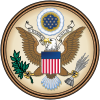- New Jersey in the American Civil War
-

Union States
in the
American Civil WarCalifornia
Connecticut
Illinois
Indiana
Iowa
Kansas
Maine
Massachusetts
Michigan
Minnesota
Nevada
New Hampshire
New Jersey
New York
Ohio
Oregon
Pennsylvania
Rhode Island
Vermont
WisconsinBorder states Delaware
Maryland
West VirginiaDual governments Territories Arizona
Colorado
Dakota
Idaho
Montana
Nebraska
New Mexico
Utah
WashingtonThe state of New Jersey in the United States provided a source of troops, equipment and leaders for the Union during the American Civil War. Though no major battles were fought in New Jersey, soldiers and volunteers from New Jersey played an important part in the war, including Philip Kearny and George B. McClellan, who led the Army of the Potomac early in the Civil War and unsuccessfully ran for President of the United States in 1864 against his former commander-in-chief, Abraham Lincoln.
Slavery and prelude to war
The Quaker population of New Jersey was especially intolerant of slavery. However, New Jersey ended up becoming the last of the northern states to abolish slavery by enacting legislation which caused the slow abolishment of slavery. Though New Jersey passed an act for the gradual abolition of slavery in 1804, it wasn't until 1830 that most blacks were free in the state. However, by the close of the Civil War, about a dozen African-Americans in New Jersey were still apprenticed freedmen. New Jersey at first refused to ratify the Constitutional Amendments that banned slavery. New Jersey was a major part of the extensive Underground Railroad system.
Civil War
On May 4, 1861, in response to President Abraham Lincoln's call to arms, the U.S. War Department directed New Jersey to fill a quota of three infantry regiments to serve a three-year term of enlistment. Recruitment took place for the new regiments all over the state, and on May 21, the 1st New Jersey Volunteer Infantry was mustered into the Union Army at Camp Olden in Trenton under Maj. Theodore T. S. Laidley of the United States Regular Army. The 9th New Jersey Volunteer Infantry, under Col. Joseph W. Allen at Camp Olden, was the last New Jersey regiment to leave the state in 1861 but the first committed to battle. Additional regiments were raised throughout the war, including cavalry and artillery.
No battles took place within New Jersey throughout the course of the Civil War. However, over 88,000 soldiers from New Jersey were part of several infantry and cavalry regiments. In total, 52 regiments were created by New Jersey soldiers during this war. 23,116 of those soldiers served in the Army of the Potomac. Soldiers from New Jersey fought generally in the Eastern theater of the Civil War[1] Over 6,000 soldiers from New Jersey lost their lives in the war. Philip Kearny, an officer from the Mexican-American War, led a brigade of New Jersey regiments under Brigadier General William B. Franklin. Kearny distinguished himself as a brilliant officer during the Peninsula Campaign, and was promoted to the position of major general.
New Jersey was one of the few states to vote for Stephen Douglas instead of Abraham Lincoln in the 1860 presidential election. The people of New Jersey also gave its electoral votes to George McClellan when he ran for President against Lincoln in the election of 1864, being the only free state that rejected Lincoln twice. McClellan later became the governor of New Jersey, from 1878 to 1881.
Many cities like Paterson and Camden, grew extremely strong through the duration of the Civil War. They produced many necessities, including clothing and war materials like ammunition. These cities prospered through constant production even after the end of the war. Cities like those of Paterson and Camden became crucial to the Northern war effort. With the Union's ability to manufacture more supplies, the Union was able to defeat the Confederates and successfully conclude the war and reunite the country[2].
References
- ^ New Jersey in the Civil War, retrieved December 18, 2005.
- ^ Stewart, Mark (2004). New Jersey: History. Chicago: Heinemann Library. ISBN 1-4034-0673-1. pg 26-29
Categories:
Wikimedia Foundation. 2010.

